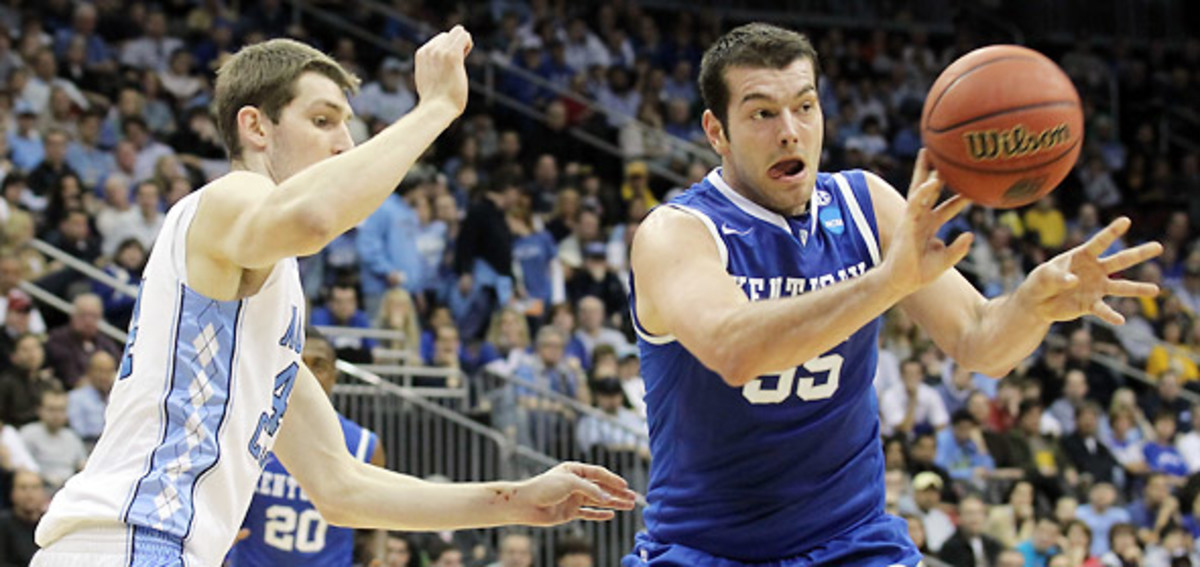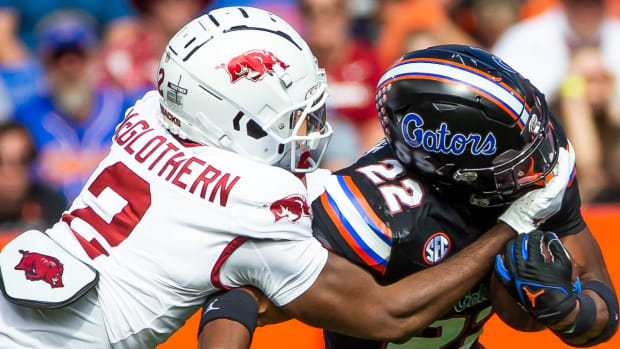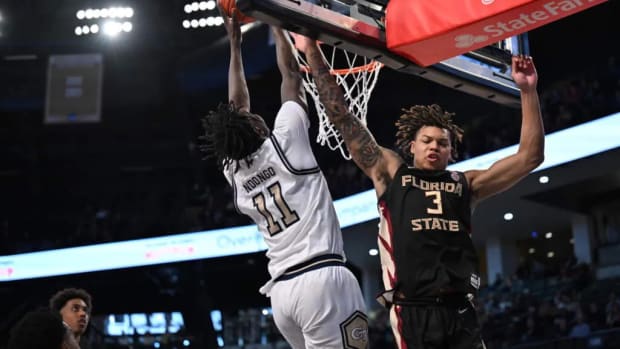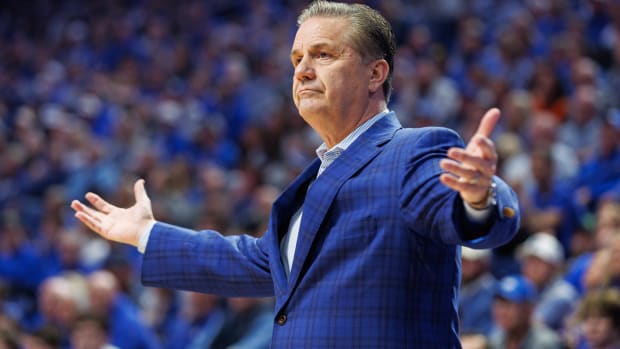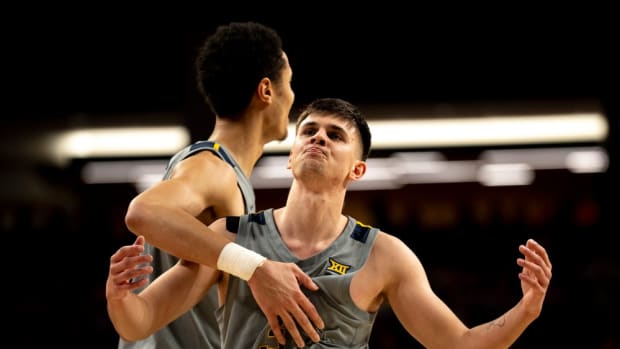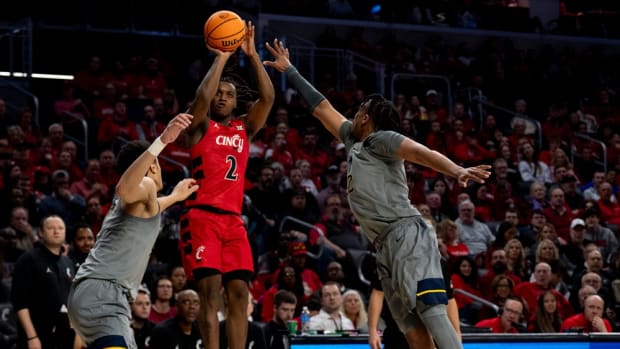Inside The Final Four Offenses
Driving, dishing Josh Harrellson: Kentucky's point center? (Nick Laham/Getty Images)
Consider this your ultimate Final Four study aid: The Tourney Blog breaks down a critical part of each team's offensive attack, in its full screen-grab glory.
Kentucky: The Harrellson Hub
Forget the Dribble Drive Motion; although the Wildcats have the most efficient halfcourt offense* left in the tournament, what they're running now is the Jorts Special. Senior center Josh Harrellson's handoff and ball-screen service has become a primary method of freeing up shooters and drivers on the perimeter, and UK coaches add new wrinkles to Jorts' attack for each game. Below are five different Harrellson-initiated scoring attempts from the past two rounds:
Example No. 1: Drive Right, Handoff
At the beginning of this set against Ohio State, Harrellson calls for the ball at the top of the key, receives it, and then drives right to initiate a handoff and screen for DeAndre Liggins. Liggins takes the handoff and drives in a curl pattern around Harrellson to the rim.
Example No. 2: Drive Right, Handoff (with a twist)
This is a similar set from the Sweet 16, except that it starts with Brandon Knight feigning setting a screen (frame 1) for Darius Miller in the right corner. Knight drops below Miller, and then uses Miller's screen (frame 2) and Harrellson's handoff (frame 3) to ditch Aaron Craft and get an open look for a three.
Example No. 3: Pick & Pop into Handoff & Roll
Here, Harrellson begins without the ball, setting a low-side ballscreen for Knight on the right wing (frame 1). Knight drives right off the screen, and Harrellson pops to the wing, where he receives the ball. Rather than reversing it or looking for a three, he immediately initiates a handoff play with Knight, driving at him down the right sideline (frames 2 + 3). When Harrellson's man, Jared Sullinger, hedges to prevent Knight from shooting an easy three, Harrellson rolls to the rim (frame 4) and receives a bounce pass from Knight, which is converted into a dunk.
Example No. 4: Top-of-key Handoff
Harrellson only needs to take one dribble to make this play happen against North Carolina. He waits at the top of the key, with the ball, as Knight cuts up from the left block (frame 1), running his man off the back of Tyler Zeller (frame 2) and then curling around Harrellson to take the handoff (frame 3). With Harrellson's backside sealing off the play, Knight can rise for a clear attempt at a three.
Example No. 5: The Keep 'Em Honest Drive
If defenders -- like Zeller -- press up too far against Harrellson to prevent his side-to-side handoff drives, he now has the green light to take them off the dribble to the rim. Here, he simply rips the ball from left to right and gets a step past Zeller, with an open lane to the rim. Zeller recovered to block Harrellson's shot in this instance, but Harrellson succeeded with this play against West Virginia, and could break it out once in the Final Four.
* Thanks to Harrellson and its brigade of quality long-range shooters, Kentucky averages the most halfcourt points per possession and highest effective field goal percentage, according to Synergy Sports Technology data:
UConn: Freeing Jeremy Lamb
Huskies star Kemba Walker creates so much offense from scratch that while he's a joy to watch, he's not exceptionally interesting in terms of Xs and Os. What's worth examining is all the effort UConn puts into freeing the Robin to Walker's Batman, Jeremy Lamb, for open jumpers and floaters in halfcourt sets. Late in the Elite Eight win over Arizona, Walker was even demanding that plays be run for Lamb, telling coach Jim Calhoun, "Let's run circle for Jeremy."
Example No. 1: The Circle of Screens
This play is what I assume Walker was referring to: Point guard Shabazz Napier slowly dribbles on a left-to-right diagonal path as Lamb (purple arrow, frame 1) gets his first screen, from Walker, at the left elbow. Lamb proceeds to move in a circle around the pack of Huskies gathered in the lane, getting a second screen at the left block (frame 2), and a third screen at the right block (frame 3). He curls off of that, receiving the ball just inside the free-throw line, with enough space for a mid-range jumper.
Example No. 2: Baseline Misdirection
It looks, at first, like this set is being run for Roscoe Smith, who's coming off the right block (frame 1) through a double screen on the left block. Walker is simultaneously dribbling off a ball-screen from Charles Okwandu, heading to the left side of the floor. But as soon as Smith clears the double screen, Walker stops in his tracks, and Lamb, who was on the left block, sprints right (frame 2) off a pick from Okwandu, who had rolled to the right block. Lamb curls off of this and receives Walker's pass with plenty of room to shoot another mid-range jumper.
Example No. 3: The S-Curve
This is another baseline set for Lamb, in which he begins off of the right block (purple arrow, frame 1), and runs on the high side of a screen from Okwandu. Rather than flash up into the lane, Lamb curves back toward the baseline to run his man under a second screen from Alex Oriakhi (frame 3). Walker hits Lamb with the pass just as he clears Oriakhi, and it results in a swished baseline floater.
Butler: Solving the Zone
The success of the Bulldogs' zone offense could be critical to them advancing to the title game. Florida surprised them with a 2-3 zone for 16 of the 73 halfcourt sets in the Elite Eight, according to Synergy Sports' possession logs, and Butler only scored on five of those 16 sets, as opposed to 27 of 57 against man-to-man D.
VCU broke out a 2-3 zone in the CAA quarterfinals against Drexel, and has been using it sporadically ever since. Synergy's logs show that the Rams played eight zone possessions (of 57 total) against USC, two (of 57) against Georgetown, 10 (of 71) against Purdue, 13 (of 81) against Florida State, and three (of 73) against Kansas.
While the Bulldogs didn't fare well at penetrating Florida's zone in isolation, they did find a few other ways to score:
Example No. 1: Center / Spread
The beauty of the new-and-improved Matt Howard is that he's just as dangerous from the perimeter (he's a 42.6 percent three-point shooter) as he is in the paint. So, against a 2-3, the Bulldogs can place center Andrew Smith in the middle of the lane, and then stretch out the back line by putting Howard in one corner and Zach Hahn in the other. In this case, Shelvin Mack fed Smith on the left block, and then he played a two-man game with Howard on the left side, kicking the ball out once Alex Tyus (the left-corner defender) dropped down to help in the post.
Example No. 2: Screen and Seal
Here, Butler runs Smith out to the perimeter to set a right-side ballscreen for Shawn Vanzant, the Bulldogs' best zone penetrator. As the screen is being set, Howard, who's on the left block, steps inside of Tyus and seals him off from the basket. This means that once Vanzant comes off the screen, he can lob a post feed to Howard, pass to Smith on a basket cut, or shoot a jumper with Howard in prime offensive rebounding position. Vanzant opted for the jumper in this instance, and Tyus fouled Howard while trying to climb over his back for the rebound.
Example No. 3: Getting Lost
Howard is the Bulldogs' most efficient spot-up shooter, averaging 1.24 points per possession in those situations, so it makes sense to get him open looks in the middle of the zone. Butler does so here by misdirecting the attention of Florida's defenders. First, Howard sets a screen against the top-left defender (frame 1) as Mack reverses the ball to Vanzant on the left side. As the ball goes left, Howard begins running right in a slow circle, almost touching the top-right defender (frame 2) before coming back to the right elbow (frame 3). The back-line defenders, at this point, are concerned with preventing a post feed to Smith, and the top-line defenders are pressed out on the guards. This creates a perfect pocket for Howard to shoot an open, free-throw length jumper (frame 4).
Example No. 4: Backdoor 'Oop
Had this play worked for Crishawn Hopkins, the sub who changed the momentum of the Florida game, he would've been an even bigger star. The Bulldogs reverse the ball to the right side, from Vanzant to Mack (frame 1), and Smith flashes to the right elbow as Howard sneaks behind Tyus to set a backscreen on the left block (frame 2). The purpose of this is to clear a path for Hopkins to run from the left wing to the rim for an alley-oop, but Tyus is agile enough to spin around Howard and prevent it. Howard then launches into a secondary action, running up to screen the top-left man of the 2-3 (frame 4) and free up a three for Vanzant, who makes a fade cut to the left wing.
No matter what defense Butler faces on Saturday, it'll be important for it to avoid settling for long twos and pound the ball inside. Using Synergy data, I compiled the following table of jump-shooting splits, showing each Final Four team's efficiency on short shots (17 feet and in), deep twos (between 17 feet and the three-point line) and long-range shots (threes). Butler is by far the least efficient team at mid-range jumpers ... and it's by far the best team when it's close to the rim:
VCU: Skeen In Space
The Rams aren't a great offensive rebounding team, ranking 217th in OReb%, mainly because their starting big man, 6-foot-9 forward Jamie Skeen, reacts to dribble penetration by floating away from the basket. He does this because he's the team's second-best three-point shooter, at 40.2 percent, and tends to get wide-open looks as defenses compress to stop drivers.
Example No. 1: Push & Pull
As pint-sized point guard Joey Rodriguez drives into the lane from the left side against Kansas, Skeen's man, Markieff Morris, slides over to help. Seeing this, Skeen (purple arrow, frame 1) fades to the top of the key, where he receives a kick-out from Rodriguez (frame 2) and has about 18 feet of space between him and the closest defender to catch and shoot.
Example No. 2: Wingman
Again, Skeen recognizes that the Morris twin guarding him (Marcus this time) has to help contain Rodriguez's penetration. Skeen steps out to the left wing (purple arrow, frame 1) and receives a kick-out from Rodriguez, who has driven right into Morris' body.
Example No. 3: Filling the Pick-and-Roll Space
Skeen starts the majority of VCU's possessions on the left block, and here, against Florida State, he waits for a screen-and-roll play (frame 1) between Rodriguez and D.J. Haley (No. 33) to occupy defenders' attention on the right wing and middle of the lane. As Skeen's defender, Bernard James (No. 5), has to step up to block Haley's path to the rim, Skeen runs out to the left wing (frame 2). Rodriguez picks up his dribble, pivots, and whips a crosscourt pass to Skeen, who shoots an open three before James can recover.
